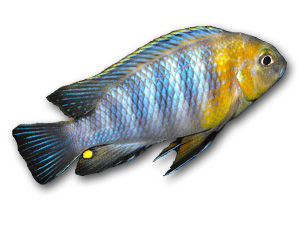Pseudotropheus Red Cheek

Quick Stats
| Size | 8" (20 cm) |
|---|---|
| Tank | 200 Litres |
| Swimming Area | Middle, bottom |
| Ph | 8.0 to 9.0 |
| Temperature | 75ºF to 78ºF(24-26°C) |
| Food | Flaked, pelleted, live and frozen foods |
Common Name:
Tropheops Sp. "Red Cheek"
Distribution:
Located from Maleri Islands to the Chinyamwezi Rocks in Lake Malawi.
Colouration:
The Tropheops Sp. "Red Cheek" is very attractive fish with a great color combination of yellow and blue. The females of this species are all yellow instead of a drab color like a lot of Mbuna, giving a nice eye-pleasing variety. Their most distinguishing naming feature is related to the yellow to red color in the area of their cheeks and chin.
Lifespan:
10 years +
Maintenance:
10 to 20% weekly water changes. Pseudotropheus Red Cheek are an aggressive fish and intolerant of others in its territory. Tank mates should be from the same area and be able to fend off their attentions. This cichlid is aggressive and is not considered to be a community fish. They can be housed with other Mbunas as long as their size and coloring is different. They can be temperamental, aggressive and very territorial especially when spawning. They are not aggressive toward females of other species, but may chase after the males. Pseudotropheus Red Cheek needs to be grouped with one male and at least 5 or more females since the males are very very rough on them. Provide lots of hiding places so the females can can get a break. You may decide, after spawning, to take the female out so she can heal and hatch her babies in peace.
Feeding:
Pseudotropheus Red Cheek is an omnivore that in the wild will shear off algae from the substrate which may contain Aufwuchs and will also eat plankton. In captivity they need vegetable matter which provides fiber in their diet to keep their intestinal tract disease free. A good quality cichlid flake or pellet can be used as a basic diet along with spirulina flake giving a varied diet to help with overall health. It would not be wise to house this fish with other genus of cichlids that eat beef heart or other mammal meat, as these foods will cause intestinal infections and death in these fish.
Substrate:
Crushed Coral Sand. These guys dig!
Tank Decor:
The set up should be a typical Lake Malawi biotope. They do fine in either freshwater or brackish freshwater but need good water movement along with very strong and efficient filtration. They need lots of caves and rocks for them to explore and to hide in, especially when the male is abusing the females. Females need lots of hiding places.
Filtration:
Provide good filtration and do frequent water changes.
Biotype:
Sediment-rich rocky area of lake Malawi.
Breeding:
The males are mainly blue accented with yellow, are larger, and have yellow egg spots on the anal fin, the females are yellow. Pseudotropheus Red Cheek has been bred in captivity and is a mouthbrooder. Once the dominant male decides to breed, he will become severely aggressive and pummel his females. You need to have at least 5 females to spread out the aggression. Like other Mbunas the males coloring will change. He will shake and circle the female, moving her to a flat rock in his territory, then the breeding begins. The female will lay between 10 - 40 eggs, depending on her size. The female then immediately takes them into her mouth. The male will then flare out his anal fin which has an 'egg spot' patterning. The female mistakes the patterning for her own eggs and tries to take them in her mouth as well. This stimulates the male to discharge sperm (milt cloud) and the female inhales the cloud of 'milt', thus fertilizing the eggs. In 7 - 10 days at about 80 - 82° F the eggs hatch. The fry are free swimming in another 10 to 17 days. Tropheops Sp. "Red Cheek" females are very good mothers and may protect the fry in her mouth for another 10 days after the fry are free swimming. These fry are a little bigger than other Mbuna fry and are a silvery color at first. Their coloring will be visible in 3 weeks. They can eat daphnia and crushed flake. They will eat voraciously so keep the water clean.